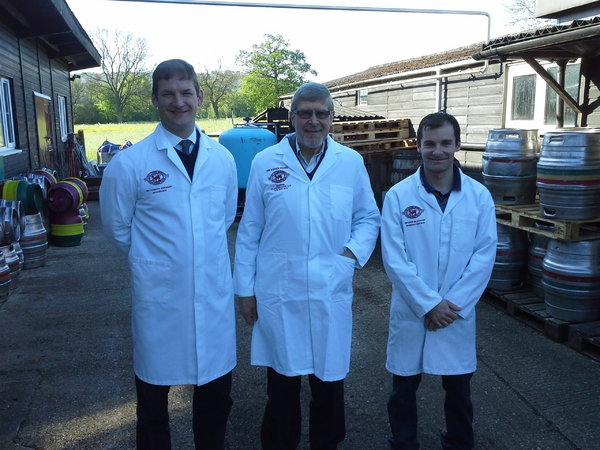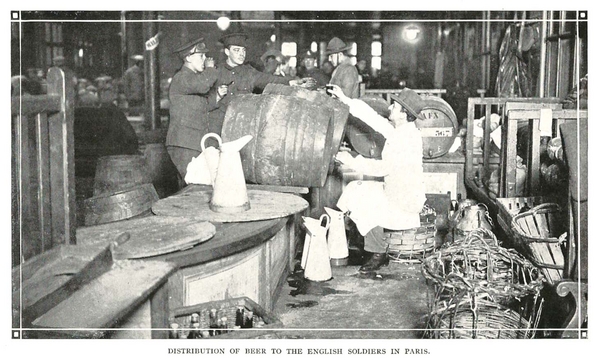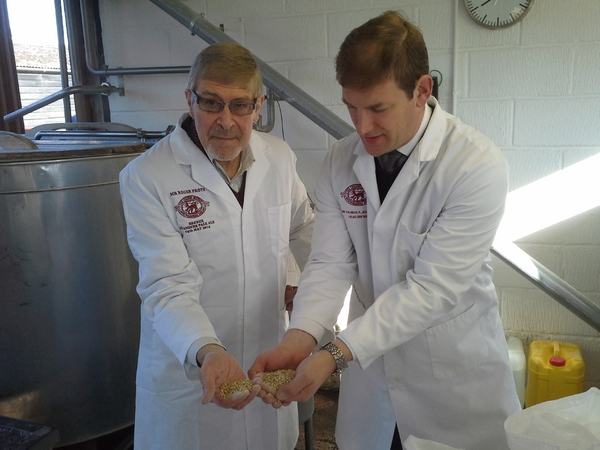Flanders Ale salutes Tommies & Belgians
Added: Tuesday, May 20th 2014

The powerful bonds linking Belgium and Britain, forged during the mud, blood and horror of the First World War, will be marked by a special Flanders Ale brewed by the Chiltern Brewery in Buckinghamshire. A number of Belgian breweries before, during and after the war produced their interpretations of British pale ale. They continue to this day, with such celebrated beers as De Koninck, Palm and Witkap.
The seeds of Belgian pale ale were sown in the 1880s when a brewer from Kent, George Maw Johnson, settled in Halle where he advised local brewers on how to make stock ale, a strong beer aged for many months: in common with Belgian lambic, it picked up a lactic tang from storage in wood.
Pale ale was given greater prominence in Belgium when John Martin from Newmarket in Suffolk opened an import agency in Antwerp in 1909. He was forced to leave Belgium during the war as a result of the German invasion but returned when hostilities ended. His main imports were Guinness stout from Dublin and Bass Pale Ale from Burton-on-Trent. Bass Pale Ale was the most celebrated beer in Britain at the time and it arrived in Antwerp in giant wooden hogsheads and was then bottled for local consumption. John Martins, as the company was called, is still in business today, run by a descendant of the founder, Anthony Martin. He also owns Timmermans lambic brewery in Itterbeek, near Brussels.
In the 1920s, John Martin added Douglas Scotch Ale to his portfolio. During World War Two, when he was again forced to leave Belgium, he helped create Bulldog Pale Ale in London, which was brewed by Courage for the Belgian market. In the 1960s it was renamed John Martins Pale Ale and production moved to Palm.
During the First World War, many Belgian breweries were either destroyed or had their copper vessels confiscated by the German army. Even monastic breweries were not spared. As a result, Belgian beer was often in short supply and British imported beer helped sustain drinkers. It was also sent in substantial quantities to refresh British troops. A photograph taken during the war, unearthed by historian Ron Pattinson, shows British troops enjoying beer in Paris when they were on leave: Ron thinks the branding on the casks – AF X – stands for Armed Forces X, the X indicating Mild Ale. At the time, the number of Xs indicated strength, so a single X Mild Ale would have been relatively low in alcohol. The army generals clearly wanted their troops to be fighting fit, rather than fighting drunk. The Tommies in the photo seem satisfied with the beer and the cellarman -- love the trilby! -- is clearly adept at storing and serving what we have to assume is cask-conditioned beer. I imagine the serving temperature would have been high by modern standards.

In 2013 I worked with Tom Jenkinson to design and brew a Ruby Ale that marked the 40th anniversary edition of the annual CAMRA Good Beer Guide, ruby being the colour used to celebrate 40th anniversaries. The bottle-fermented beer went down well, in every sense, and Tom was keen to do another collaborative beer. I suggested a Flanders Ale to mark the First World War and the close brewing links between Belgium and Britain and sent him a few old recipes I had found. Tom then conducted his own diligent research and came up with a recipe for a beer that uses pale malt and Vienna malt, along with a Belgian version of the English Challenger hop.
In spite of the name pale ale, many interpretations of the style use a small amount of slightly darker or stewed malt, such as English crystal or European caramalt. Tom opted for Vienna malt that, despite the name, comes from Bamberg in Germany, so the beer reaches out to all sides in the conflict of 1914-18. The Challengers come from the major Belgian hop-growing region around Poperinge, which is close to Ieper, known as Ypres to the French and “Wipers” to the Tommies. The four battles of Ieper cost a shocking number of lives: 400,000 men died at the third battle, Passchendaele, alone. Every evening at 8 o’clock, a bugler sounds the Last Post at the Menin Gate, where the names of 54,896 names of unknown soldiers killed in the war are engraved in the stone walls.
It was therefore a sombre moment at 8am on 14 May when Tom Jenkinson (left in top photo), brewer Dave McGovern (right) and I went into the brewhouse at Chiltern to start the mash for our Flanders Ale. Dave had already heated the mash tun -- “warming the pot,” Tom said – and we loaded sacks of pale malted barley, malted wheat and Vienna malt into a hopper. From there the grain flowed into the mash tun where it was mixed with pure, hot brewing “liquor” – the brewers’ name for water.

Once the mash was under way we left nature to run its course, with natural enzymes in the grain converting starch to fermentable sugar (pictured above: Tom and I examine the grains used in the beer). We enjoyed a suitable breakfast of coffee and croissants, then it was time to run the wort, the sweet extract, from the mash tun to the copper for the boil with hops. The beer marks a major departure for the Jenkinson family who are staunch believers in using all British ingredients in their beers. But Tom felt strongly that our Flanders Ale had to cross national borders if it’s to truly commemorate the war, the beers brewed at that time and those who gave their lives.
The copper boil lasted one hour 15 minutes. After cooling it was pumped to fermenters and thoroughly mixed with yeast. Once primary fermentation is over, the beer will condition for several weeks. It will be available at the end of July on the eve of the date that marks the start of the war.
The full recipe is:
Flanders Ale, 6.5% alcohol by volume; original gravity 1061.5.
Malt: 200kg pale malt, 75kg malted wheat, 25kg Vienna malt.
Hops: start of boil 0.54kg @ 7.5% Belgian Challenger; after 30 minutes 0.53kg @ 7.5%; at end of boil 3.87kg @ 7.5%. Units of Bitterness 25-28. Yeast: 4.5kg.
*The beer will be available to be pre-ordered before the launch: www.chilternbrewery.co.uk.
Thanks to Sally Dorling (photos) and Ron Pattinson.









